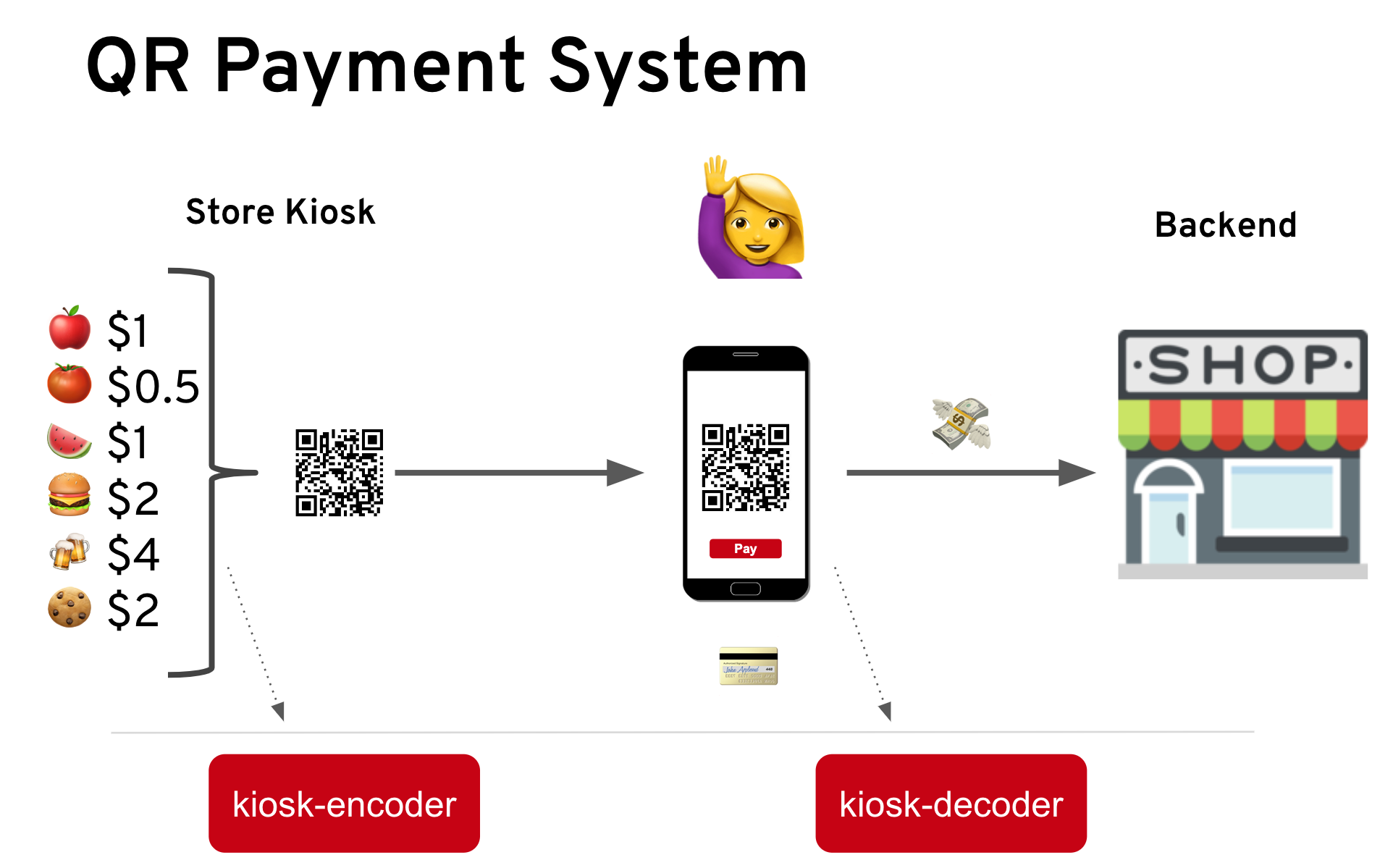Sample serverless QR payment system using Knative.
QR (quick response) codes are increasing in popularity for a variety of use cases, from loyaty programs to complete cashless payment systems, which is what we will simulate on this tutorial as a sample serverless application.
There are 2 services as part of the architecture:
- A Kiosk QR encoder: The in-store service that generates a QR code when a customer hit a Payment button after scanning all products. It can be scanned to process the payment.
- A Kiosk QR reader: A web application that can be used from a mobile device or web broswer. A customer would have her credit card on file and after scanning the QR code the system process the payment using that information. Once payment is processed another backend service would notify the in-store Kiosk of the event.
The serverless aspects of the application allow for the system to auto-scale based on store demand like during peak hours or scale down during hours of less store traffic.
- An OpenShift 4 cluster with:
- Knative v0.7+
- Tekton v0.6+
- Istio and Kiali
kn,s2ianddockeron the development environment.
Let's start by creating one of the services using kn - Which is the official Knative CLI, still in early stages and under development. At the time I'm writing this there are no released builds for kn yet, so you will have to build one manually following these instructions.
Once you have a kn binary in your $PATH proceed to the next steps.
We are going to use s2i tool to build the application and produce a container without creating a Dockerfile.
s2i build qr-encode centos/python-36-centos7 markito/qr-encode:v1
Push the image to a container registry. For example: docker push markito/qr-encode:v1 or use the internal container registry in OpenShift. For details on that check this blog post.
Build the application using docker build, assuming a user would then need to create a specific Dockerfile describing some dependencies for the application.
docker build qr-decode/ -t markito/qr-decode:v1
Push the image to a container registry. For example: docker push markito/qr-decode:v1
kn service create kiosk-encoder --image markito/qr-encode:v1 -n markito
Hit the endpoint ("kiosk-encoder/encode") to test using curl or a browser. To obtain the URL for the service use kn service get and use the value from the domain column.
kn service create kiosk-decoder --image markito/qr-decode:v1 -n markito
In order to show how auto-scale works, you can add some load to the cluster using a tool like wrk. There is a shell script under the qr-encode project that can be used to cause some load for 30s.
wrk -t10 -c10 -d30s http://kiosk-encoder.markito.apps.openshift.codeready.cloud/encode
Use the Openshift console to visualize pods coming up and down or monitor the live traffic using Kiali.
Create a new Knative service and deploy a Quarkus based application. If you cloned this repository the source code for this app is under the quarkus folder.
To build the Quarkus version of the kiosk application, use the plugin integrated with Maven that allows for a streamlined experience to produce containers. From the quarkus-kiosk directory you can execute:
-
Build the application
./mvnw package -Dnative-image.docker-build=true -
Build the container image using the JVM profile
docker build -f src/main/docker/Dockerfile.jvm -t markito/quarkus-decoder:v1 .
kn service create quarkus-qrdecoder --image markito/quarkus-decoder:v1 -n markito
This will create a new Knative service and since we have a single revision available it will receive 100% of the traffic.
Now let's modify something in our application, like the background color of the landing page, then build and deploy a new version of the service.
docker build -f src/main/docker/Dockerfile.jvm -t markito/quarkus-decoder:v2 .
PS: Note the use of v2 as part of the tag.
Then create a new revision of the service:
kn service update quarkus-qrdecoder --image markito/quarkus-decoder:v2 -n markito
List the revisions available for a given service with kn revision list:
kn revision list -s quarkus-qrdecoder
NAME SERVICE GENERATION AGE CONDITIONS READY REASON
quarkus-qrdecoder-dnhlx-3 quarkus-qrdecoder 2 46m 3 OK / 4 True
quarkus-qrdecoder-gwbgs-1 quarkus-qrdecoder 1 6h41m 3 OK / 4 True
Now using the name of these revisions let's peform some A/B testing and give them 50% of traffic each.
kn service update quarkus-qrdecoder --traffic quarkus-qrdecoder-gwbgs-1=50,quarkus-qrdecoder-dnhlx-3=50
Please note that the revision names might differ on your environment.
Observe the traffic going to the different versions of the service using Kiali or by accessing the service URL.
TBD.
